You've spent months perfecting your t-shirt designs. Now, you're finally ready to bring them to life. But as you research printing options, you're faced with a crucial decision that will impact everything from your budget to the aesthetic of your brand. Should you go with the bold, tactile appeal of screen printing, or embrace the detailed flexibility of digital printing?
It’s crucial to understand exactly how each printing method aligns with your creative vision, production needs, and business goals. As a general overview, screen printing is ideal for large quantities and bold graphics, known for its unmatched durability and vibrant colors. Digital printing, including direct-to-garment technology, excels at smaller batches with intricate designs, perfect for testing new concepts or creating limited editions.
Whether you're designing custom apparel for the first time or scaling an existing collection, the right printing method is often the difference between a successful launch and an expensive mistake. Each offers distinct advantages, from setup costs and turnaround time to print quality and environmental impact.
Drawing from years of experience helping designers navigate these decisions, The Pattern Cloud will break down the key differences between screen printing and digital printing, helping you choose the method that best serves your project's unique requirements.
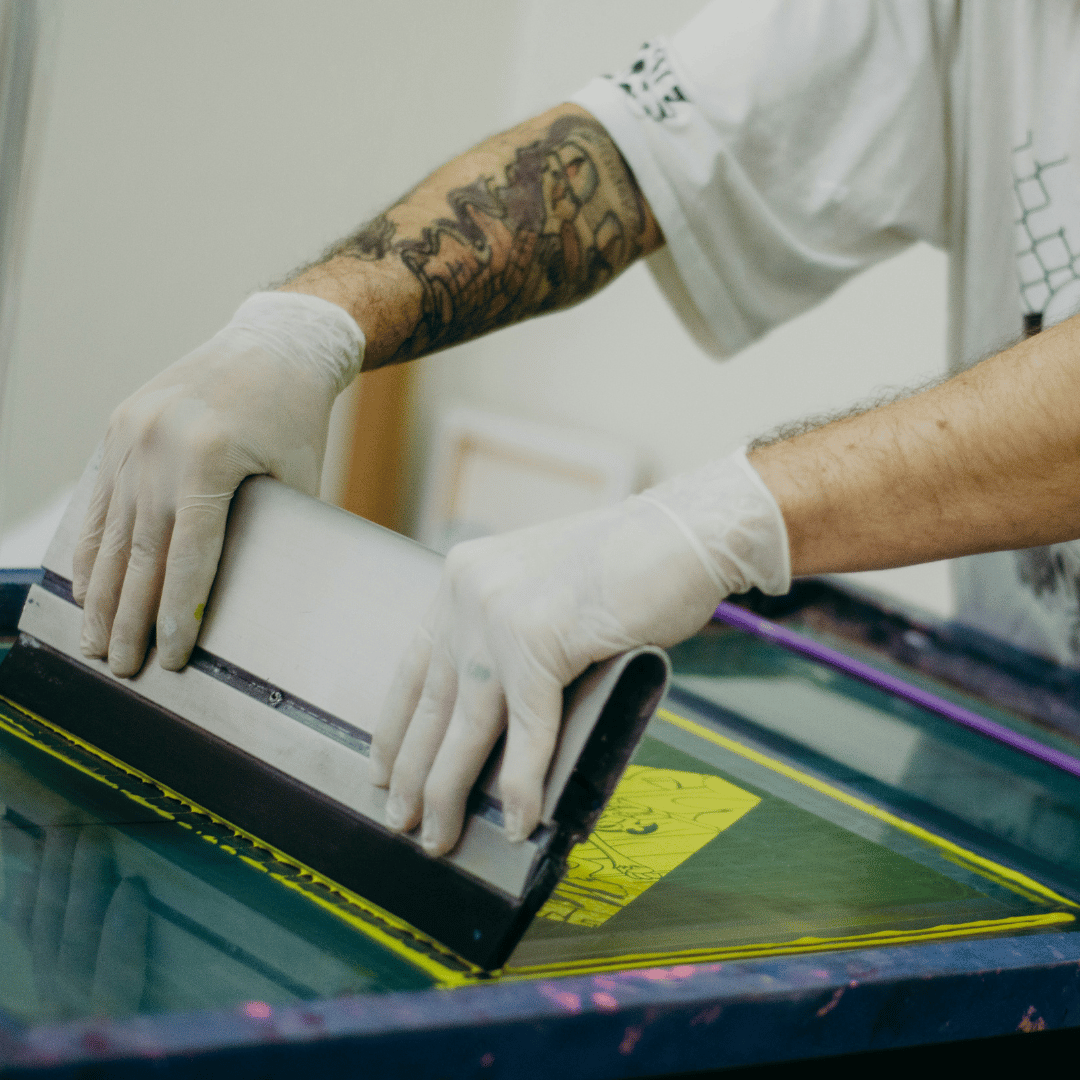
Comparative Analysis: Screen Printing vs Digital Printing
There are fundamental differences between these two printing methods, essential for making an informed decision. Each technique serves different needs, from production volume to design complexity. Here is a quick summary:
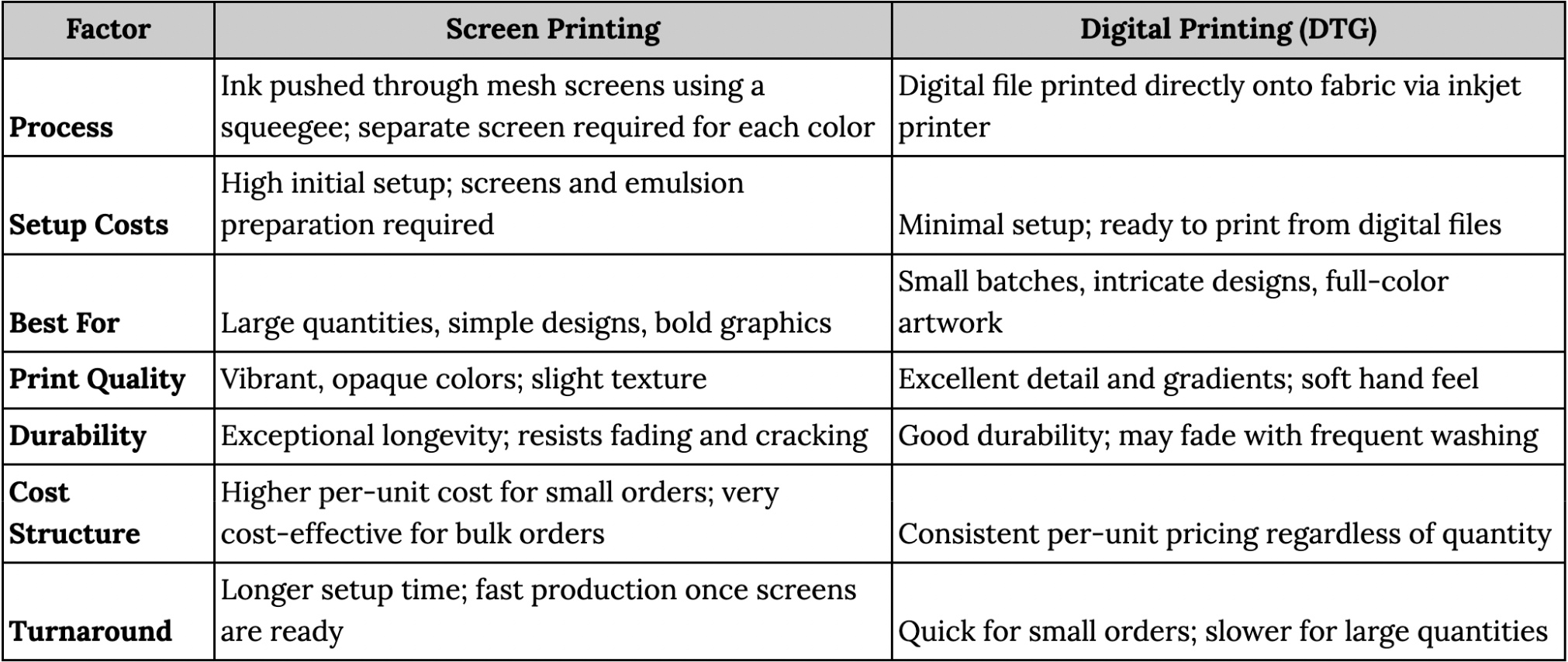
Quality and Appearance
Screen printing delivers unmatched vibrancy and opacity, especially on dark fabrics. The traditional screen printing process creates thick ink layers that produce bold, tactile prints with excellent color matching capabilities. This method is particularly useful when using specialty inks like plastisol ink, metallics, and puff ink to create unique textures and finishes.
Digital printing, notably DTG printing, is preferable when reproducing intricate details, photographic images, and complex designs with multiple colors. The printing technology integrates seamlessly with fabric fibers, resulting in a softer feel and excellent reproduction of gradients and fine details that would be challenging with traditional screen printing.
Durability and Longevity
Screen printing works by creating thick, durable ink layers that bond firmly with your textile’s surface. When properly cured, these prints often outlast the garment itself, maintaining their intensity through countless wash cycles. Water-based inks and plastisol formulations both offer excellent durability, though plastisol typically lasts longer.
Digital printers use advanced water-based inks that may show signs of wear sooner than screen-printed designs. However, proper pretreatment and curing can significantly extend the life of digitally printed designs, making them suitable for high-quality custom apparel.
Cost Factors and Production Economics
The economics of each printing method depend on order size and design complexity. Screen printing requires significant initial setup—creating screens, mixing inks, and preparing the printing surface—but becomes highly cost-effective for bulk orders since the setup costs are distributed across many pieces.
Digital printing eliminates setup costs entirely, making it ideal for smaller orders, one-off pieces, or print-on-demand services. The consistent per-unit cost structure makes it perfect for testing new designs or producing limited-edition pieces without minimum order requirements.
Production Time and Workflow
Since screen printing's setup time can be substantial, it’s best for rapid and efficient production bulk orders, where setup time is justified by volume.Digital printing offers quick turnaround times for small orders, with minimal setup time required.
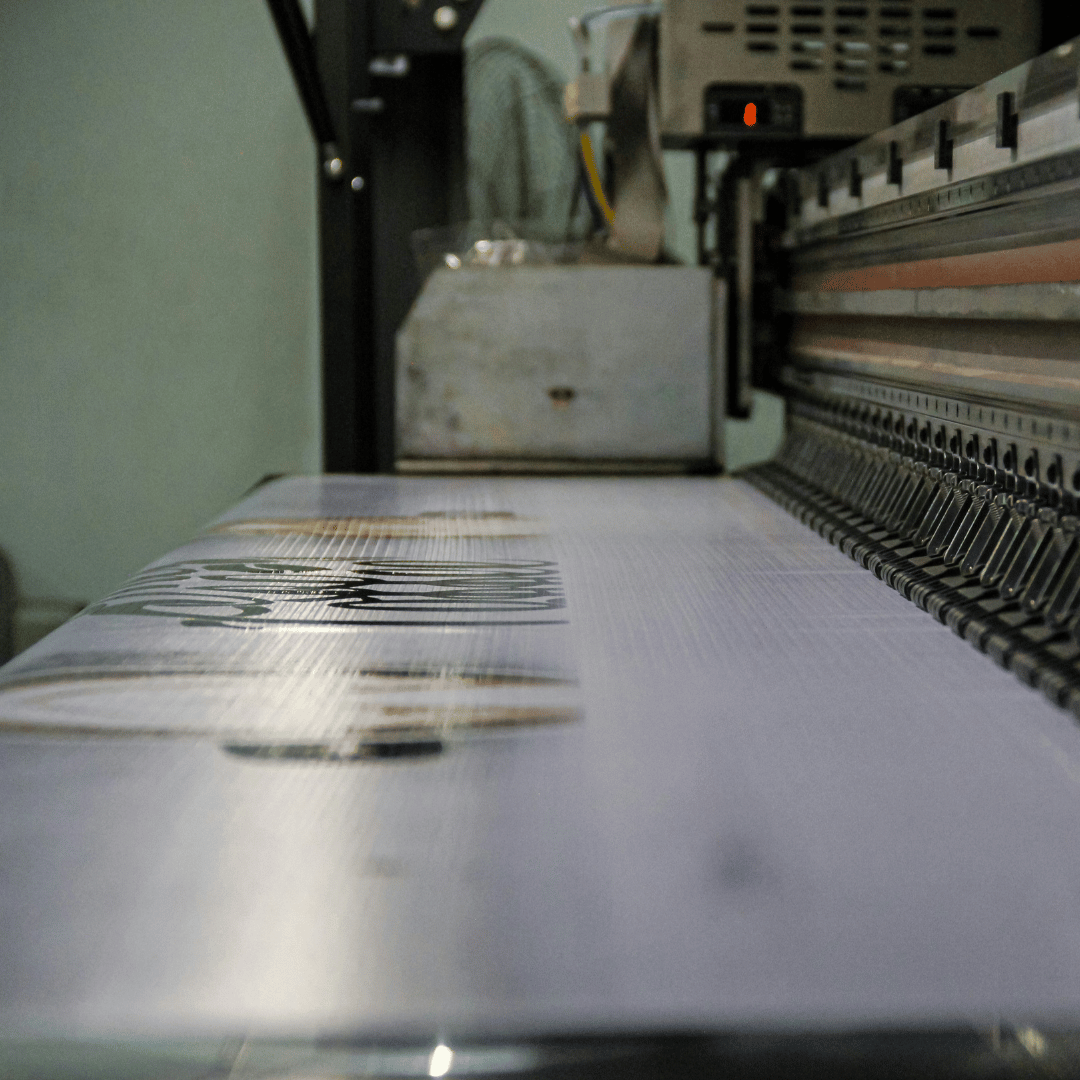
Choosing the Right Printing Method for Your Project
The key to selecting the ideal printing method lies in understanding your specific project requirements and how each technique aligns with your goals. Here's a practical framework to guide your decision-making process.
Order Quantity and Volume Considerations
For large orders (typically 50+ pieces), screen printing becomes increasingly cost-effective as setup costs are distributed across more units. This makes it ideal for established collections, uniforms, or promotional campaigns where consistent branding across bulk orders is essential.
For smaller orders, samples, or one-off custom pieces, digital printing offers unmatched flexibility. With no minimum order requirements, you can test new t-shirt designs, create limited editions, or fulfill custom apparel requests without significant upfront investment.
Material and Fabric Compatibility
Screen printing works exceptionally well across diverse textiles, from cotton and blends to hoodies and specialty fabrics. It's particularly effective on dark shirt colors, where the thick ink layers provide excellent opacity and vibrant colors that stand out against the substrate.
Digital printing performs best on 100% cotton and light-colored garments, where the printing ink can properly penetrate and bond with the fabric. While advances in printing technology have expanded compatibility, performance on synthetic materials or dark fabrics may require additional pretreatment or may not achieve the same print quality as screen printing.
Design Complexity and Artistic Vision
Choose screen printing when your designs feature bold graphics, solid colors, or require precise color matching for brand consistency. This method excels with simple yet impactful designs, specialty inks, and situations where Pantone color accuracy is crucial for brand identity.
Opt for digital printing when working with intricate designs, photographic images, or artwork featuring gradients and complex color transitions. The ability to print directly from digital files makes it an excellent choice for detailed artwork, full-color designs, or frequently changing graphics that would be prohibitively expensive with traditional screen printing.
Budget and Timeline Factors
Screen printing requires higher initial investment but offers lower per-unit costs for larger quantities. Digital printing provides predictable, consistent pricing regardless of order size, making budget planning simpler for variable quantities.
As far as timeline, digital printing offers rapid turnaround for small orders with minimal setup time. Screen printing requires longer initial preparation but can produce large quantities quickly once the printing process begins.
Leveraging Technology for Better Decisions
Modern design platforms like The Pattern Cloud streamline the entire workflow from concept to production. With features like automated invoicing, real-time analytics, and professional shop tools, designers can efficiently manage their printing projects regardless of the chosen method. The platform's design upload capabilities and customer engagement tracking help optimize your printing strategy based on actual performance data.
Making Your Final Decision
Consider screen printing for:
- Large quantities and bulk orders
- Bold, simple designs with limited colors
- Projects requiring maximum durability
- Consistent brand color matching
- Specialty ink applications
Choose digital printing for:
- Small batches and custom orders
- Intricate details and photographic prints
- Rapid prototyping and testing
- Full-color, gradient-heavy designs
- Print-on-demand business models
By carefully evaluating these factors against your specific project needs, you can confidently select the printing method that will deliver the best results for your creative vision and business objectives.
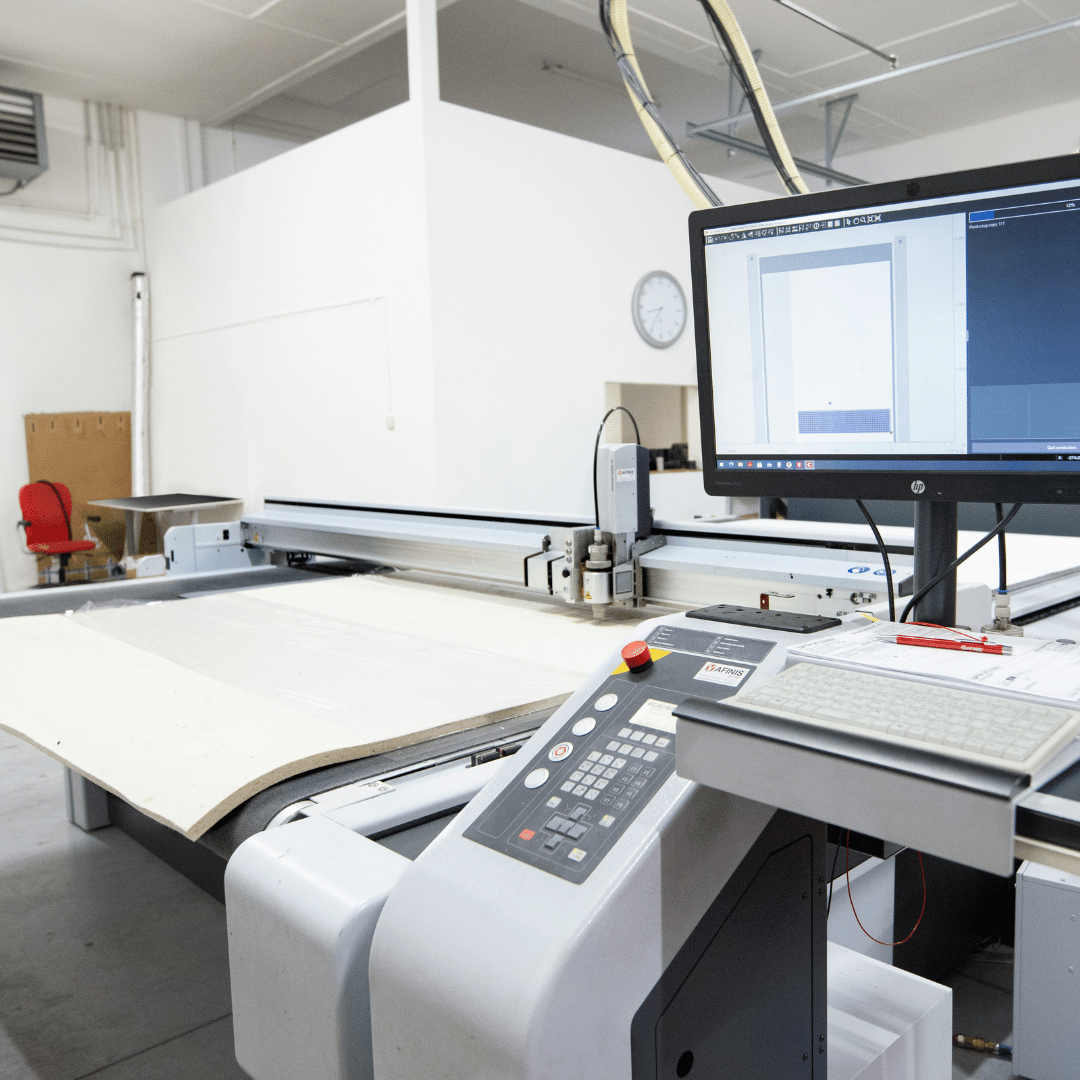
Environmental Considerations
Sustainability is on everyone’s mind, and is of equal importance in the printing industry. Understanding the environmental impact of different printing methods helps designers make responsible choices that align with their values and brand commitments.
Ink Types and Chemical Usage
Traditional screen printing has historically relied on plastisol ink, which contains PVC and requires chemical solvents for cleanup. These inks present environmental challenges due to their chemical composition and the emulsion and cleaning agents needed during the screen printing process.
The good news is, with significant evolution within the industry, water-based inks can serve as a sustainable alternative, reducing reliance on harsh chemicals while maintaining excellent print quality. These eco-friendly inks are biodegradable and produce less environmental impact during both printing and disposal.
Digital printing, particularly direct-to-garment printing, typically uses water-based, pigment inks that are free from heavy metals and hazardous chemicals. This approach not only improves workplace safety but also reduces the environmental burden associated with printing ink disposal and cleanup.
Resource Consumption and Waste Generation
Energy consumption, water usage, and waste production are additional environmental factors to consider. Screen printing can be resource-intensive, especially when curing inks at high temperatures and cleaning mesh screens between print runs. The process generates various forms of waste, including leftover inks, used screens, and washout water containing chemical residues.
Digital printing offers inherent advantages in waste reduction. Digital printing generally produces less waste and uses fewer chemicals than traditional screen printing, making it a more eco-friendly choice for many projects. With no screens to prepare or clean, digital printers minimise material waste and reduce water consumption. The print-on-demand nature of digital printing also eliminates overproduction, a major source of textile waste in the fashion industry.
Energy Efficiency and Carbon Footprint
Today, modern digital printing machines are being designed with energy efficiency in mind, using advanced printing technology that reduces power consumption. The setup time for digital printing is minimal, further reducing energy usage per print job.
Screen printing's energy requirements vary significantly based on ink type and curing methods. While plastisol inks require high-temperature curing, water-based inks can often be cured at lower temperatures or even air-dried, reducing energy consumption considerably.
Sustainable Practices and Future Considerations
Both printing methods can be optimised for sustainability through conscious choices. Screen printing operations can implement proper waste management systems, use water-based inks, and invest in energy-efficient curing equipment. Digital printing can focus on using recyclable ink cartridges, sustainable substrates, and minimising packaging waste.
The printing surface itself—whether cotton, synthetic blends, or specialty textiles—plays a crucial role in overall environmental impact. Choose organic or recycled fabrics whenever possible.
Making Environmentally Conscious Decisions
For designers prioritising environmental responsibility, digital printing often represents the more sustainable choice, particularly for smaller orders and frequently changing designs. The reduced chemical usage, minimal waste generation, and elimination of setup materials make it ideal for eco-conscious brands.
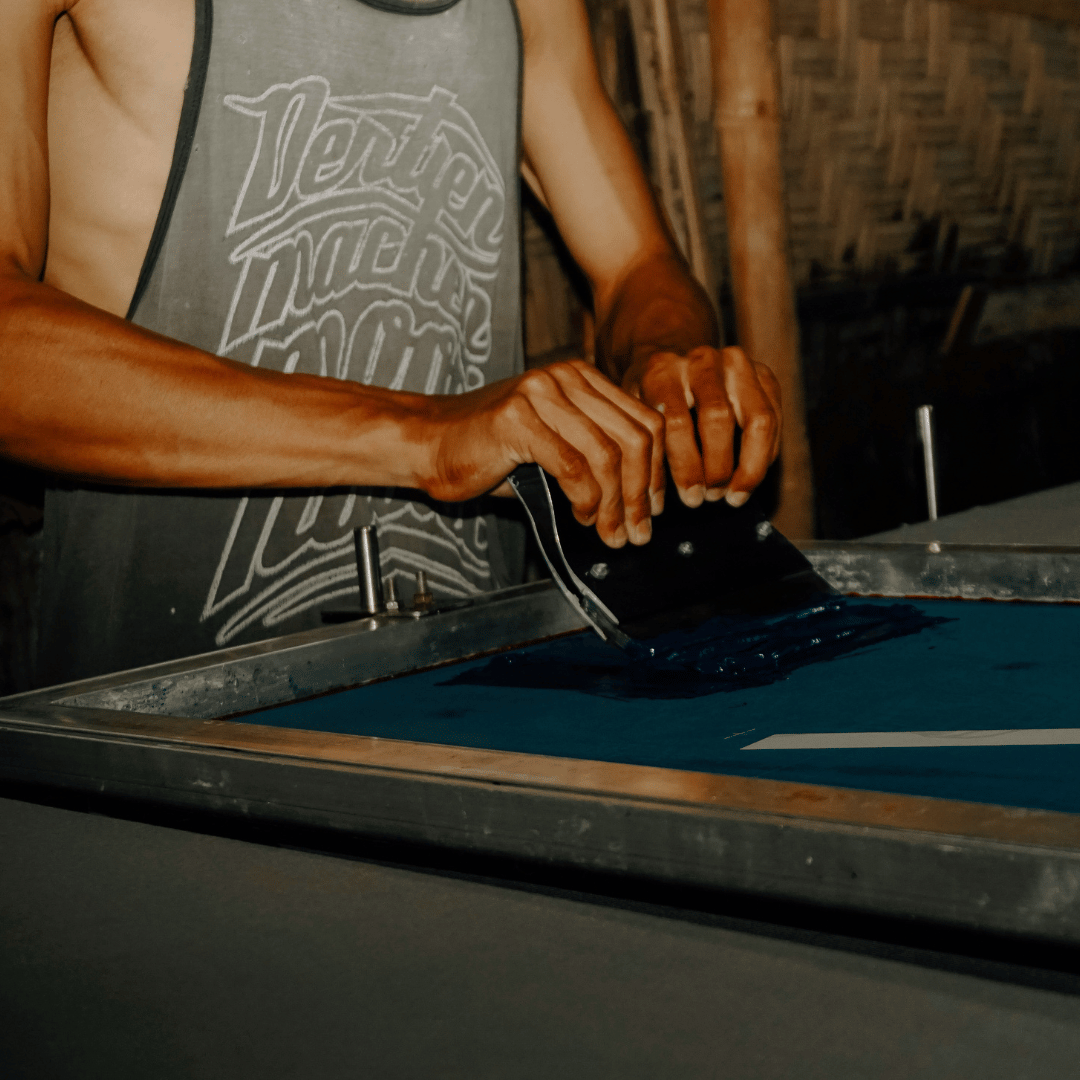
FAQs
Which printing method is more cost-effective for small orders—screen printing or digital printing?
Digital printing is typically more cost-effective for small orders because it eliminates setup costs entirely. There's no need to create screens, mix specialty inks, or invest in initial setup time. Screen printing becomes more economical for larger quantities (usually 50+ pieces) where the setup costs are distributed across many units, dramatically reducing the per-unit price.
Are there significant environmental differences between screen printing and digital printing?
Yes, there are notable environmental differences. Digital printing generally has a smaller environmental footprint, using less water, producing less waste, and often employing eco-friendly, water-based inks. Traditional screen printing can generate more chemical waste, especially when using plastisol ink and cleaning solutions. However, modern screen printing using water-based inks and efficient waste management can also be environmentally responsible.
How should I prepare my designs for screen printing versus digital printing?
For screen printing, keep designs bold and simple. Use solid, flat colors without gradients, limit your color palette to 1-6 colors, and ensure each color is on a separate layer. Vector files (AI or PDF) work best, or use layered PSD files. Specify Pantone colors for precise color matching and brand consistency.
For digital printing, you have more creative freedom. Work in CMYK color mode, ensure high resolution (300 dpi minimum at print size), and feel free to include gradients, photographic elements, or complex designs. Save files as TIFF, PSD, or JPEG depending on your printer's requirements.

